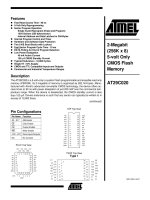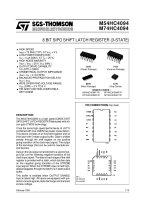Điện tử viễn thông LGW2EChapter7Presentation khotailieu
Bạn đang xem bản rút gọn của tài liệu. Xem và tải ngay bản đầy đủ của tài liệu tại đây (683.22 KB, 153 trang )
Chapter 7
Packet-Switching
Networks
Network Services and Internal Network
Operation
Packet Network Topology
Datagrams and Virtual Circuits
Routing in Packet Networks
Shortest Path Routing
ATM Networks
Traffic Management
Chapter 7
Packet-Switching
Networks
Network Services and Internal
Network Operation
Network Layer
z
Network Layer: the most complex layer
z
z
Requires the coordinated actions of multiple,
geographically distributed network elements
(switches & routers)
Must be able to deal with very large scales
z
z
Billions of users (people & communicating devices)
Biggest Challenges
z
z
Addressing: where should information be directed to?
Routing: what path should be used to get information
there?
Packet Switching
t1
t0
Network
z
z
z
Transfer of information as payload in data packets
Packets undergo random delays & possible loss
Different applications impose differing requirements
on the transfer of information
Network Service
Messages
Messages
Segments
Transport
layer
Transport
layer
Network
service
Network
service
Network
layer
Network
layer
Network
layer
Network
layer
Data link
layer
Data link
layer
Data link
layer
Data link
layer
layer
Physical
layer
Physical
layer
Physical
layer
End
system
Physical
α
z
z
z
End
system
β
Network layer can offer a variety of services to transport layer
Connection-oriented service or connectionless service
Best-effort or delay/loss guarantees
Network Service vs. Operation
Network Service
z Connectionless
z
z
Datagram Transfer
Internal Network
Operation
z Connectionless
Connection-Oriented
z
Reliable and possibly
constant bit rate transfer
z
z
IP
Connection-Oriented
z
z
Telephone connection
ATM
Various combinations are possible
z Connection-oriented service over Connectionless operation
z Connectionless service over Connection-Oriented operation
z Context & requirements determine what makes sense
Complexity at the Edge or in the
Core?
C
12
1
End system
α
4 3 21
2
3
2
21
1
1
1
12
3
2
21
Medium
A
1 Physical layer entity
3
2 Data link layer entity
1
2
12
3
B
2
1
Network
Network layer entity
2
21
End system
β
123 4
3 Network layer entity
4 Transport layer entity
The End-to-End Argument for
System Design
z
An end-to-end function is best implemented at a
higher level than at a lower level
z
z
z
End-to-end service requires all intermediate components to
work properly
Higher-level better positioned to ensure correct operation
Example: stream transfer service
z
z
Establishing an explicit connection for each stream across
network requires all network elements (NEs) to be aware of
connection; All NEs have to be involved in reestablishment of connections in case of network fault
In connectionless network operation, NEs do not deal with
each explicit connection and hence are much simpler in
design
Network Layer Functions
Essential
z Routing: mechanisms for determining the
set of best paths for routing packets requires
the collaboration of network elements
z Forwarding: transfer of packets from NE
inputs to outputs
z Priority & Scheduling: determining order of
packet transmission in each NE
Optional: congestion control, segmentation &
reassembly, security
Chapter 7
Packet-Switching
Networks
Packet Network Topology
End-to-End Packet Network
z
z
Packet networks very different than telephone
networks
Individual packet streams are highly bursty
z
z
User demand can undergo dramatic change
z
z
Statistical multiplexing is used to concentrate streams
Peer-to-peer applications stimulated huge growth in traffic
volumes
Internet structure highly decentralized
z
z
Paths traversed by packets can go through many networks
controlled by different organizations
No single entity responsible for end-to-end service
Access Multiplexing
Access
MUX
To
packet
network
z
z
z
Packet traffic from users multiplexed at access to network into
aggregated streams
DSL traffic multiplexed at DSL Access Mux
Cable modem traffic multiplexed at Cable Modem Termination
System
Oversubscription
z
r
r
Access Multiplexer
•••
•••
z
r
Nr
z
nc
z
z
Nc
z
N subscribers connected @ c bps to mux
Each subscriber active r/c of time
Mux has C=nc bps to network
Oversubscription rate: N/n
Find n so that at most 1% overflow probability
Feasible oversubscription rate increases with size
N
r/c
n
N/n
10
0.01
1
10
10 extremely lightly loaded users
10
0.05
3
3.3
10 very lightly loaded user
10
0.1
4
2.5
10 lightly loaded users
20
0.1
6
3.3
20 lightly loaded users
40
0.1
9
4.4
40 lightly loaded users
100
0.1
18
5.5
100 lightly loaded users
Home LANs
WiFi
Ethernet
Home
Router
To
packet
network
z
Home Router
z
z
z
LAN Access using Ethernet or WiFi (IEEE 802.11)
Private IP addresses in Home (192.168.0.x) using Network
Address Translation (NAT)
Single global IP address from ISP issued using Dynamic
Host Configuration Protocol (DHCP)
LAN Concentration
Switch
/ Router
z z z
z
z
z
z
z z z
z
z
z
LAN Hubs and switches in the access
network also aggregate packet streams that
flows into switches and routers
Servers have
redundant
connectivity to
backbone
Campus Network
Organization
Servers
To Internet or
wide area
network
s
Gateway
Backbone
s
R
R
R
S
R
Departmental
Server
S
S
R
R
s
s
High-speed
Only
outgoing
campus leave
packets
backbone
net
LAN
through
connects dept
router
routers
s
s
s
s
s
s
s
Connecting to Internet Service
Provider
Internet service provider
Border routers
Campus
Network
Border routers
Interdomain level
Autonomous
system or
domain
Intradomain level
s
LAN
s
s
network administered
by single organization
Internet Backbone
National Service Provider A
National Service Provider B
NAP
NAP
National Service Provider C
z
z
Private
peering
Network Access Points: set up during original
commercialization of Internet to facilitate exchange of traffic
Private Peering Points: two-party inter-ISP agreements to
exchange traffic
National Service Provider A
(a)
National Service Provider B
NAP
NAP
National Service Provider C
(b)
NAP
Private peering
RA
Route
Server
RB
LAN
RC
Key Role of Routing
How to get packet from here to there?
z Decentralized nature of Internet makes
routing a major challenge
z
z
z
z
Interior gateway protocols (IGPs) are used to
determine routes within a domain
Exterior gateway protocols (EGPs) are used to
determine routes across domains
Routes must be consistent & produce stable flows
Scalability required to accommodate growth
z
Hierarchical structure of IP addresses essential to
keeping size of routing tables manageable
Chapter 7
Packet-Switching
Networks
Datagrams and Virtual Circuits
The Switching Function
z
z
z
Dynamic interconnection of inputs to outputs
Enables dynamic sharing of transmission resource
Two fundamental approaches:
z
z
Connectionless
Connection-Oriented: Call setup control, Connection
control
Backbone Network
Switch
Access Network
Packet Switching Network
User
Transmission
line
Network
Packet
switch
Packet switching network
z Transfers packets
between users
z Transmission lines +
packet switches
(routers)
z Origin in message
switching
Two modes of operation:
z Connectionless
z Virtual Circuit
Message Switching
z
Message
z
Message
Message
z
Source
Message
Switches
Destination
z
z
Message switching
invented for telegraphy
Entire messages
multiplexed onto shared
lines, stored & forwarded
Headers for source &
destination addresses
Routing at message
switches
Connectionless
Message Switching Delay
Source
T
t
Switch 1
t
τ
Switch 2
Destination
t
t
Delay
Minimum delay = 3τ + 3T
Additional queueing delays possible at each link









